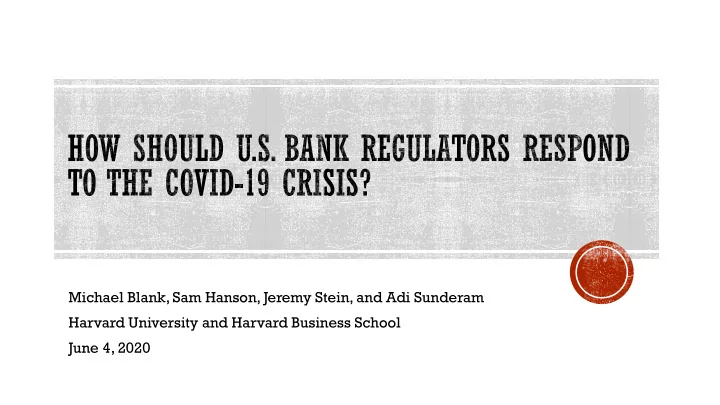

Michael Blank, Sam Hanson, Jeremy Stein, and Adi Sunderam Harvard University and Harvard Business School June 4, 2020
Lessons from the Global Financial Crisis of 2008-09 Market-based signals this time around A table-top COVID stress test Promoting dynamic resilience in times of stress Some specific policy recommendations
In hindsight, was a major policy failure not to stop payouts and push for equity raises sooner. Not appealing for banks to issue equity at 40% decline from peak. But by waiting, had to do it after a 70% decline, with support from government and specter of nationalization.
Bank stock prices as useful early warning signal. In cross-section, pre- Lehman stock price decline is highly informative about subsequent loan losses. Much better than accounting-based metrics.
Bank stocks down by about 40%: much more than overall market, or even value stocks. In cross-section, bigger price declines for banks with more loans/assets, especially C&I loans and consumer loans. As in GFC, seems to be real fundamental information in bank stock prices. C&I leveraged loan prices down by 10% (even with Fed support of credit markets). Weighted CMBS prices down by 9%.
We use slightly modified version of Fed’s CLASS model: maps macro assumptions into evolution of category-level loan losses and bank-level capital ratios based on historical time-series relationships. Unemployment rate as primary macro driver; also residential and commercial real estate indices. Study 21 BHCs included in 2020 CCAR. Obvious caveats about extrapolating past history to the present case: dynamics of unemployment path are very different. Think of as a crude attempt to get a handle on magnitude of what could happen if things continue to go south. In our most optimistic case, with unemployment peaking at 17.8%, CET1 drops by $389B and CET1 ratio falls from 11.5% to 7.3%. In most pessimistic case, with unemployment peaking at 28.7%, CET1 ratio falls to 5.5%.
Cross-validation: banks with bigger stock-price declines show bigger hits to CET1 ratios in our stress tests. These tend to be consumer-focused banks.
In a simple model, Greenwood et al (2017) show that optimal response to a major shock to bank capital consists of two elements: A loosening of marginal capital-ratio requirements on new loans and other desired activities. As would happen e.g. with relaxation of a counter-cyclical capital buffer. Or with exclusion of Treasuries and reserves from denominator of SLR. An increase in dollars of equity in the banking system. Dividend stoppages and equity raises. Was a fundamental insight of 2009 SCAP: focus on dollars raised, not just capital ratios. Analogy to taxation: want to simultaneously broaden the base to maintain revenues, while cutting marginal tax rates to encourage desirable activities. US policy thus far has been almost entirely focused on loosening capital-ratio requirements. Unlike many other countries which have imposed dividend stoppages on banks.
Short run Immediate halt to all bank dividends and share repurchases. Encourage substantial new common equity raises. Longer-term Consider ways to more explicitly incorporate market-price information into stress-testing process. Not mechanically, but as a way of imposing some discipline on forward-looking assumptions during times of rapid change. Make it a default setting that counter-cyclical capital buffer is turned on in good times. Gives more scope to relax in a crisis. Exclusion of reserves from denominator of SLR is likely to be (and should be) semi-permanent. Not at all clear that Treasuries should be excluded on ongoing basis.
Recommend
More recommend